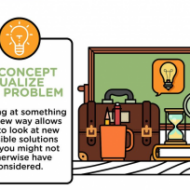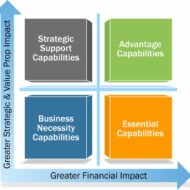Posted by Managementguru in Business Ethics, CSR, Marketing, Strategy
on Jan 9th, 2015 | 0 comments

Strategic Change-Beyond the Boxes The major focus of corporate strategy is to formulate a method by which any business can adapt to a changing environment enabling to improve its competitive advantage. The corporate strategy theory presents us with the following questions: Where are we now? Where do we want to be? How do we get there? Corporate Self-Analysis The logic is to examine the current status of the business. Areas that come under this self-analysis purview include: Is the business aware of who its stake-holders are? If you are not going to engage your customers or users, then your business becomes product-centric and not cutomer-centric. What are the long-term objectives of your concern? Without a definitive vision how will you ever design and achieve your short-term goals! Does your company have a mission statement? See the mission statement of Mc.Donalds – McDonald’s brand mission is to be our customers’ favorite place and way to eat and drink. Our worldwide operations are aligned around a global strategy called the Plan to Win, which center on an exceptional customer experience – People, Products, Place, Price and Promotion. What are your present business strategies? If your company’s presence is not felt in the market (forget being a market leader always, though that would be the dream spot of all big corporate companies), or your product is not selling by itself, then there has some serious thinking to be done about your present strategies. Focus on what went wrong, try to get inspired by your competitors’ moves (Ha! Its not copying my friend! ), gear up your advertising department to reach the audience. Also try to find out if there are any black sheep in your stay leaking confidential statistics and strategic business moves. Are they simple to understand and communicate to the workforce? If you are not able to pitch your idea to your workforce in a matter of just 15 minutes, then it is very well clear that you are not clear about what you’ve conceptualized. What is the marketplace scenario? Is it in the growth/decline phase? Sometimes it is better to start a business at bad times. Hiring will be easy, cost will be under control and you can experiment boldly because you have nothing to lose. Who might be your biggest competitors? This takes serious effort and planning and ask your core team to do their home-work properly. “Understand that a competitor is created because you are weak”. Review your business internally, look at your business-does it support growth and adaptability to change? This depends upon the leader who serves as the biggest inspiration for people down the line. The culture he has developed plays a big role in deciding this aspect wherein flexibility and employee engagement are part and parcel of it. How effective are your production processes? How well do sales/personnel/marketing/finance sections perform? How well does the business control its internal resources? This is a separate entity and the most crucial element of an enterprise. Expansion in accordance with the demand on one side and keeping up with the technology advance on the other side and what about the third side – the “WORKFORCE” in caps! Tending to the employee morale is the biggest challenge of modern times. HR MANAGERS have to have up-to-date knowledge on the labor laws and government policies on the security aspects of employees. A small case study on the Fast Food Giant McDonalds: U.S. CMO Deborah Wahl, who joined the fast food giant McDonalds company in early 2014, said in a video about the brand refresh that the company will move from a philosophy of “billions served” —...

Posted by Managementguru in Business Management, Financial Management, Marketing, Strategy
on Jul 15th, 2014 | 0 comments

What is Financial Capability? The availability, usage and management of funds have a bearing on the financial capability of an organization and ability to implement its strategies. A financial manager has to pool, deploy and allocate financial resources taking into consideration the capital or long term investments, working capital or short-term liabilities and repayment capacities. Factors that influence financial capability of an organization: 1. Factors related to source of funds: Capital structure, procurement of capital, controllership, financing pattern, working capital availability, borrowing, capital and credit availability, reserves and surplus, and relationship with lenders, banks and financial institutions. 2. Factors related to usage of funds: Capital investment, fixed asset acquisition, current assets, loans and advances, dividend distribution and relationship with shareholders. 3. Factors related to #management of funds: Financial accounting and budgeting systems, management control system, state of financial health, cash, inflation, return and risk management, cost reduction and control, and tax planning and advantages. Typical Strengths that Support Financial Capability: • Access to financial resources • Amicable relationship with financial institutions • High level of credit worthiness • Efficient capital budgeting system • Low cost of capital as compared to competitors • High level of shareholder’s confidence • Effective management control system • Tax benefits due to various government policies The examples given below show how strengths and weakness affect the financial capability of organizations: • A company faced many problems due to instability in the top management, an unfavorable public image, unfavorable government relations etc., but it had inherent strengths like a huge amount- to the tune of Rs.1000 crores invested in fixed assets which the company used for funding its diversification plans. Here we see one particular strength over-shadowing all other weaknesses which can be rectified in due course of time. • A scooter company had collected nearly Rs.1150 crores as advance for booking of scooters, but within five years, its cash position deteriorated owing to sudden and unforeseen cancellation of bookings and withdrawal of deposits, resulting in a huge interest burden. Had the company had a strong financial backup, it would have survived the trouble. Matching strengths and weaknesses with opportunities and threats requires that a firm should direct its strengths towards exploiting opportunities and blocking threats while minimizing exposure of its weaknesses at the same...




